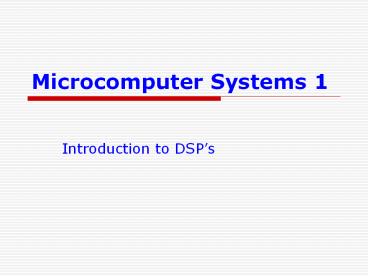Microcomputer Systems 1 PowerPoint PPT Presentation
Title: Microcomputer Systems 1
1
Microcomputer Systems 1
- Introduction to DSPs
2
Introduction to DSPs
- Definition
- DSP Digital Signal Processing/Processor
- It refers to
- Theoretical signal processing by digital means
(subject of ECE3541), - Specialized hardware (processor) that can process
signals in real-time (subject of this course
ECE35513) - This classs focus is on
- Hardware Architecture of a real-world DSP
platform ADSP BlackFin Processor, - Software Development on DSPs, and
- Applied Signal Processing theory and practice.
3
Introduction to DSPs
- DSPs process signals
- Signal a detectable physical quantity or
impulse (as a voltage, current, or magnetic field
strength) by which messages or information can be
transmitted (Webster Dictionary)
4
Introduction to DSPs
- Signal Characteristics
- Signals are Physical Quantities
- Signals are Measurable
- Signals are Analog
- Signals Contain Information.
- Examples
- Temperature oC
- Pressure Newtons/m2 or Pa
- Mass kg
- Speed m/s
- Acceleration m/s2
- Torque Newtonm
- Voltage Volts
- Current Amps
- Power Watts
- In this class, analog signals are electrical.
- Sensors are devices that convert other physical
quantities (temperature, pressure, etc.) to
electrical signals.
5
Introduction to DSPs
- DSP process digital signals
- Analog-to-Digital Converter (ADC)
- Binary representation of the analog signal
- Digital-to-Analog Converter (DAC)
- Digital representation of the signal is converted
to continuous analog signal. - Analog ? Continuous
6
ADC
a) Continuous Signal
b) Amplitude Quantized Signal
fs
AnalogLow-passFilter
Sampleand Hold
x(t)
xa(nT)
Quantizer
DSP
xn
c) Amplitude Time Quantized Digital Signal
7
Example of ADC
8
DAC
c) Continuous Low-pass filtered Signal
b) Analog Signal
a) Digital Output Signal
DSP
Digital toAnalog Converter
AnalogLow-passFilter
y(t)
yn
ya(nT)
9
Why Processing Signals?
- Extraction of Information
- Amplitude
- Phase
- Frequency
- Spectral Content
- Transform the Signal
- FDMA (Frequency Division Multiple Access)
- TDMA (Time Division Multiple Access)
- CDMA (Code Division Multiple Access)
- Compress Data
- ADPCM (Adaptive Differential Pulse Code
Modulation) - CELP (Code Excited Linear Prediction)
- MPEG (Moving Picture Experts Group)
- HDTV (High Definition TV)
- Generate Feedback Control Signal
- Robotics (ASIMOV)
- Vehicle Manufacturing
- Process Control
- Extraction of Signal in Noise
- Filtering
- Autocorrelation
- Convolution
- Store Signals in Digital Format for Analysis
- FFT
10
Digital Telephone Communication System Example
11
Typical Architecture of a DSP System
Analog Signal Processing
Analog SignalConditioning
Sensor
Digital Signal Processing
Digital SignalConditioning
ADC
DSP
DAC
12
Why Using DSP?
- Low-pass Filtering example
- Chebyshev Analog Filter of Type I and Order 6,
vs. - FIR 129-Tap Filter
13
Chebyshev Analog Filter of Type I
- Chebyshev Type I (Pass-Band Ripple)
- 6-Pole
- 1.0 dB Pass-Band Ripple
- Non-liner Phase
- MATLAB fdatool
- Order 6
- Fs 10,000 Hz
- Fpass 1,000 Hz
- Apass 1 dB
14
Example of a 3-rd order Active low-pass filter
implementation
15
Magnitude Response of Chebyshev Filter Type I
Order 6.
16
Pass-Band Ripple 1.0 dB
17
Digital Filter Design
- FIR,
- 129-Tap,
- Less then 0.002 dB Pass Band Ripple
- Linear Phase
18
FIR Filter Magnitude Response
19
Less then 0.002 dB Pass-Band Ripple
20
Analog vs. Digital Implementations
- Analog
- Cons
- Approximate Filter Coefficients
- Only standard components available
- Environment Temperature dependent
- Less accurate
- Can be used only for designed purpose
- Pros
- Operate in real-time
- Digital (DSP)
- Cons
- Real-time operation is dependent on the speed of
processor and the complexity of problem at hand. - Pros
- Accurate Filter implementation to desired
precision - Operation independent on the environment.
- Flexible
- DSPs can be reprogrammed.
21
DSP Implementation of the FIR Filter
- 129-tap digital filter requires 129
multiply-accumulates (MAC) - Operation must be completed within sampling
interval (1/Fs) to maintain real-time. - Fs10000Hz 10kHz ? 100 ?s
- ADSP-21xx family performs MAC process in single
instruction cycle - Instruction rate gt 129/100 ?s 1.3 MIPS
- ADSP-218x 16-bit fixed point series 75 MIPS.
22
End

